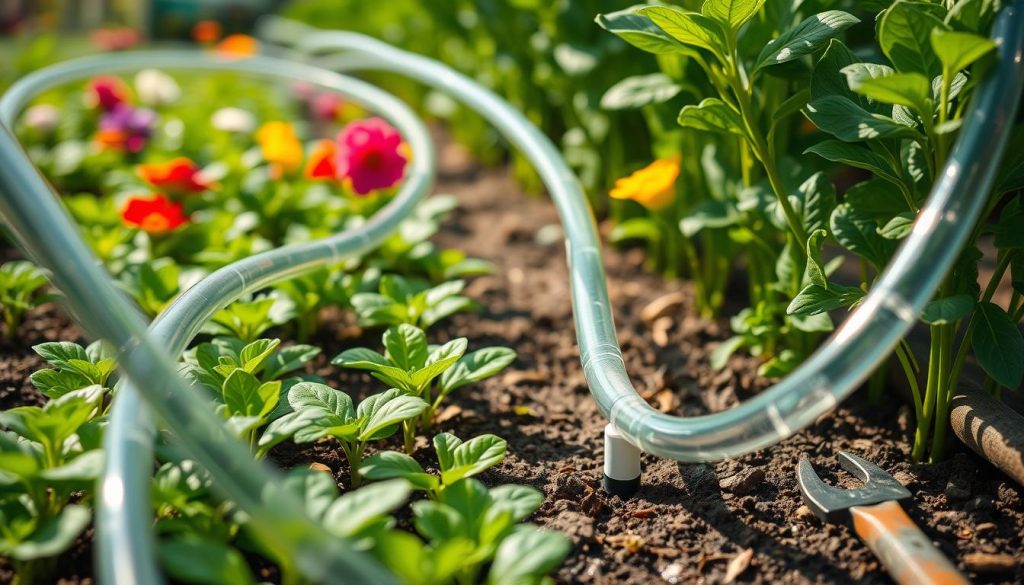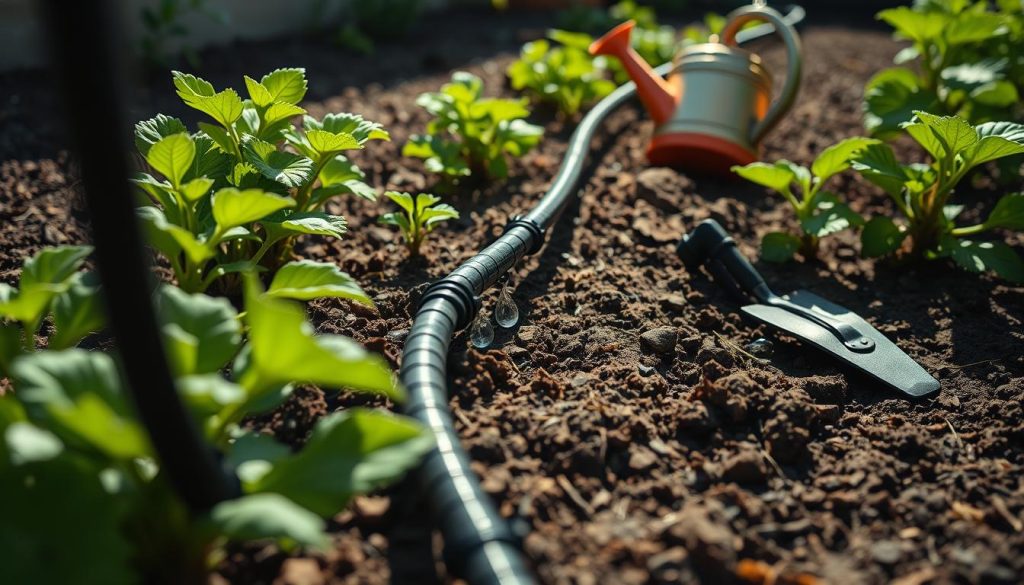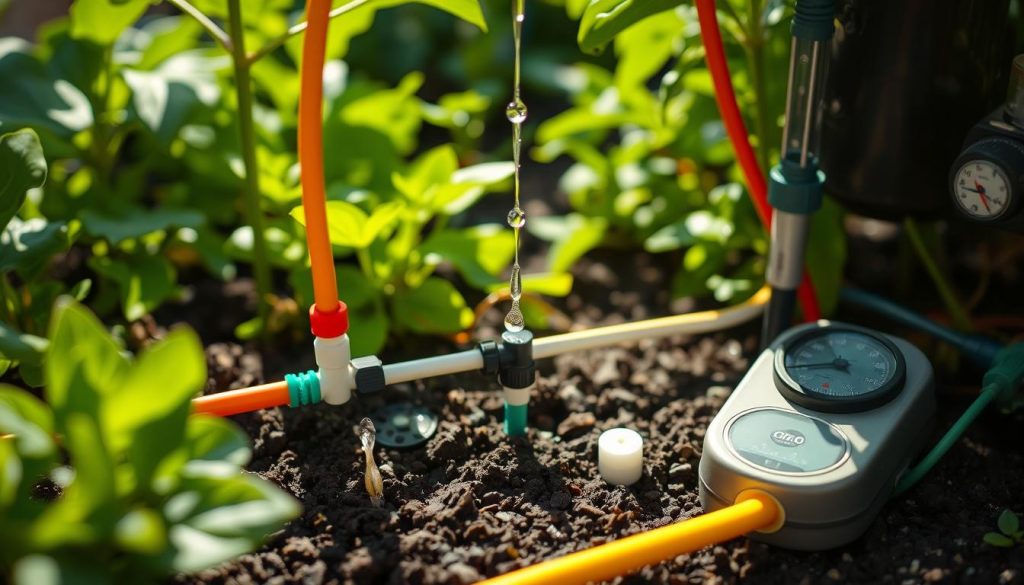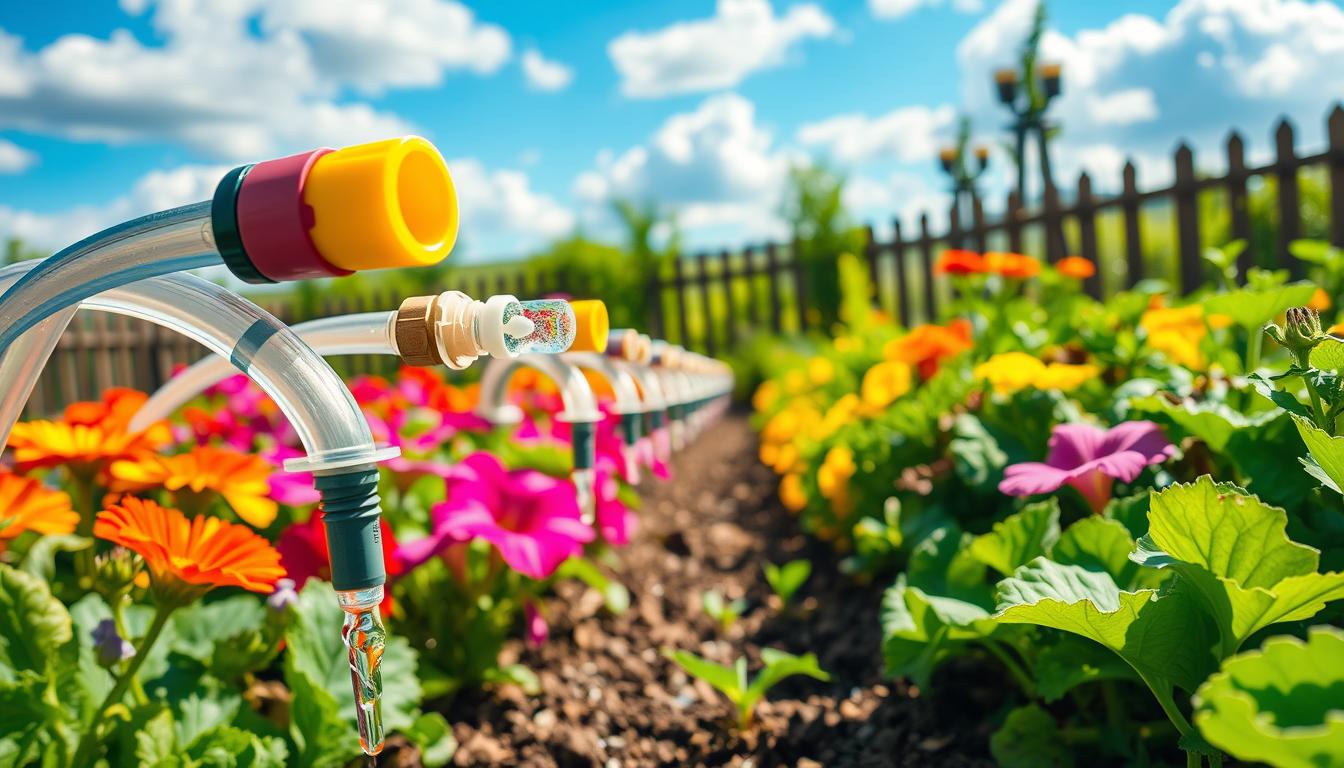I’m excited to share my personal experience with DIY drip irrigation systems. They are a cost-effective and efficient way to water my garden. As a gardener, I’ve always wanted to conserve water and reduce waste. This led me to try DIY irrigation.
Using DIY drip irrigation systems has changed my garden for the better. It helps me save water and cut down on waste. I’ll guide you through designing, installing, and maintaining a DIY drip irrigation system. I’ll also highlight the benefits of DIY irrigation.
In this article, I’ll give you an overview of my DIY drip irrigation system experience. I’ll cover the basics of DIY irrigation. It’s a valuable tool for gardeners who want to conserve water and reduce waste.
Introduction to Drip Irrigation
Drip irrigation is a smart way to water plants, sending water straight to the roots. It cuts down on evaporation and runoff. This makes it perfect for those who want to save water.
It’s a system that uses tubes and emitters to water plants. It ensures plants get the right amount of water, avoiding too much or too little. You can set up a schedule that fits your plants’ needs.
What is Drip Irrigation?
Drip irrigation waters plants right at the roots. It’s great for big farms and small gardens alike. It helps save water and cuts down on waste.
Benefits of Drip Irrigation Systems
Here are some key benefits:
- It saves water by reducing evaporation and runoff.
- It boosts crop yields and plant health by providing steady water.
- It’s good for the environment by cutting down on water waste.
Drip irrigation is a smart choice for watering plants. It lets you tailor watering to your plants’ needs. This saves water and boosts plant growth.
Materials Needed for My DIY System
To make a DIY drip irrigation system, I had to get some materials. I needed things like tubing, emitters, filters, and fittings. It was important to plan well to make sure I had everything.
I also thought about using micro irrigation to save water.
The key things I needed for my DIY drip irrigation system were:
- Tubing and pipes for water distribution
- Emitters for releasing water to plants
- Filters to prevent clogging
- Fittings for connecting pipes and emitters
Essential Supplies List
Choosing the right materials was key. I picked durable tubing and pipes that could handle the outdoors. The quality of these parts is crucial for the drip system’s success.

Tools for Installation
For setting it up, I needed tools like pipe cutters, drills, and wrenches. These tools helped me cut and connect the pipes. They also helped me secure the fittings. Having the right tools made the job easier and faster.
Optional Accessories
Adding things like timers and pressure regulators can make the system better. These extras let me control the water flow and pressure better. Using these and high-quality supplies, I made a drip irrigation system that works well.
Designing My Drip Irrigation Layout
Creating an efficient garden irrigation system starts with a good layout design. I first look at my garden’s needs. This includes the soil type, plant species, and climate. Knowing these helps me plan the drip irrigation system’s layout.
For example, if some plants need more water, I place emitters closer to them. This ensures they get enough moisture.
A well-designed DIY irrigation system boosts my garden’s health and productivity. Drip irrigation delivers water right to the roots. This cuts down on evaporation and runoff.
It also saves water and reduces the chance of overwatering. Overwatering can harm my plants.
When planning the water flow, I think about my garden’s slope and elevation. This ensures water flows evenly and doesn’t collect in one spot. I also pick the best spots for emitters and tubing.
I consider the plants’ mature size and spacing. This way, I create a system that’s both efficient and effective.
Assessing My Garden Needs
- Soil type: clay, sandy, or loam
- Plant species: vegetables, flowers, or shrubs
- Climate: hot, cold, or temperate
Planning the Water Flow
By considering these factors, I design a drip irrigation system that fits my garden’s needs. Whether I’m using a DIY kit or a custom system, the goal is to deliver water efficiently. This means water goes straight to the roots, reducing waste and runoff.
Installing the Main Line
Installing the main line is key when setting up a DIY drip irrigation system. This step connects the water source, lays the tubing, and secures the joints. Using quality materials and following the right steps is crucial for success.
A well-designed irrigation system boosts your DIY drip irrigation’s efficiency. Choosing the right materials and following the correct installation process is vital. This way, you can create a watering system that meets your garden’s needs.
Connecting the Water Source
To connect the water source, attach the main line to a faucet or water pump. Always use a filter to keep debris out. This prevents clogs and ensures smooth operation.
Laying the Tubing
When laying the tubing, plan carefully to ensure even spacing and coverage. You can use PVC or polyethylene tubing. Bury it 6-8 inches deep to protect it from damage and extreme temperatures.

Securing Joints and Fittings
To secure joints and fittings, use glue, clamps, and tape. This prevents leaks and ensures proper pressure. Regular checks can help spot issues early.
By following these steps and using the right materials, you can build an efficient DIY drip irrigation system. Always follow proper installation procedures for a long-lasting system and healthy plants.
Setting Up Emitters
As I worked on my DIY drip irrigation system, I learned how important emitters are. They send water straight to plant roots. This is key for saving water and cutting down on waste. In a drip system, emitters make sure plants get the right amount of water.
To set up emitters, I looked at the different types. I found drip emitters and micro-sprinklers. These can be bought at various retailers as part of irrigation supplies. Here are some things to think about when picking emitters:
- Flow rate: Different plants need different amounts of water. So, it’s important to pick emitters with adjustable flow rates.
- Spacing: Emitters need to be spaced right so plants get enough water.
- Type: Drip emitters and micro-sprinklers are used for different things. It’s important to pick the right one for your needs.
After picking the right emitters, I put them in the best spots for water delivery. I also adjusted the flow rates for each plant type. This way, I made a water-saving micro irrigation system that helped my plants grow well.
Testing and Adjusting the System
After setting up my DIY drip irrigation systems, I need to test and adjust them. This ensures they work well. I start by turning on the water and checking for leaks or blockages.
I watch how the system performs, making sure water flows right and emitters spread it evenly. If problems arise, like clogged emitters, I fix them. This helps me get the watering schedule just right for my plants.
Initial Test Run
To start the test, I follow these steps:
- Turn on the water supply and check for leaks
- Inspect the tubing for kinks or blockages
- Monitor the system’s performance and adjust as needed
Troubleshooting Common Issues
If I find any problems, I tackle common ones like:
- Clogged emitters
- Faulty tubing
- Incorrect water pressure

Fine-Tuning the Watering Schedule
Once I’ve fixed any issues, I adjust the watering schedule. I tweak the flow rates and timing to meet my plants’ needs.
Maintenance Tips for Longevity
To keep my drip irrigation system working well, I focus on regular upkeep. I check the system for damage or wear, clean emitters and tubing to avoid clogs, and adjust it with the seasons. Using top-notch irrigation supplies and micro irrigation methods helps prevent corrosion and other problems.
Some important maintenance tasks are:
- Regularly inspecting the system for signs of damage or wear
- Cleaning emitters and tubing to prevent clogging
- Making seasonal adjustments to accommodate changing weather conditions
By sticking to these tips and choosing the best irrigation supplies, I can make my drip irrigation system last longer. This ensures my plants get the water they need efficiently.
Keeping a record of maintenance is also key. It helps me stay on schedule with checks and cleanings. This way, I can quickly spot and fix any issues. By combining these maintenance tips with micro irrigation and quality supplies, I create a dependable drip irrigation system for my garden.
My Overall Experience and Recommendations
Building my own DIY drip irrigation system was incredibly rewarding. I learned a lot that I want to share with others who garden or like DIY projects.
Lessons Learned from My Project
Key lessons from my DIY irrigation project are important. First, planning well is crucial. Then, paying attention to details during setup is key. And, keeping the system in good shape is essential.
Understanding your garden’s needs and designing a smart water flow plan are vital. These steps help build a successful system.
Tips for First-Time DIYers
If you’re new to DIY drip irrigation, start by knowing your garden’s layout and watering needs. Spend time researching the right emitters, fittings, and accessories for your garden. Feel free to try new things and adjust as you go.
Final Thoughts on DIY Drip Irrigation
Building a DIY drip irrigation system was both tough and rewarding. Its water-saving benefits are clear. I urge all gardeners to try it.
With the right tools, patience, and preparation, you can create a custom DIY garden irrigation system. It’s worth the effort.

